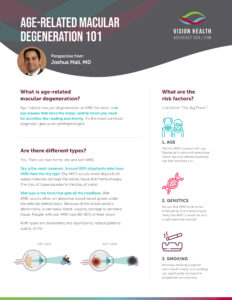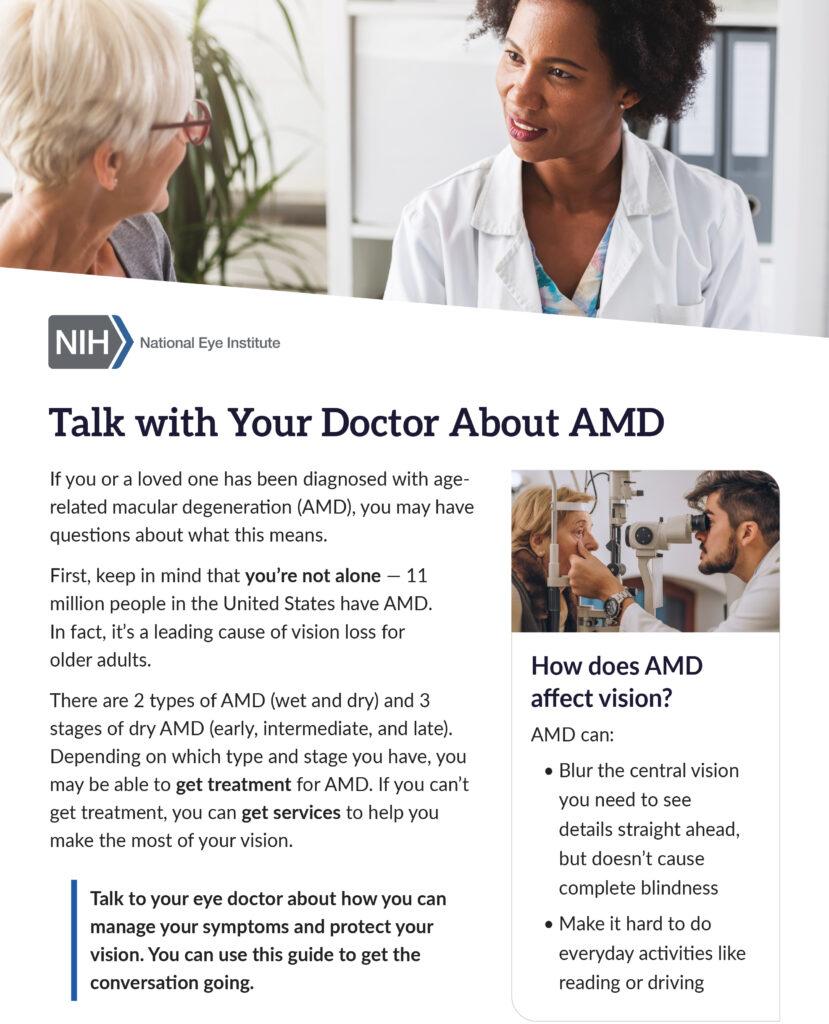What is Macular Degeneration?
Tap below to view the whole article by Dr. Mali
Talk With Your Doctor About AMD
Click below to download your personal guide
Age-related macular degeneration (AMD) is the world’s leading causes of irreversible blindness in the United States.
The disease affects the macula located at the back of your eye which is the part of the retina that lets you see fine detail like images in front of you, facial features or letters on a page. AMD is not painful and can occur in one or both eyes. How quickly the disease progresses vary from person to person and from eye to eye.
When the disease advances rapidly it may lead to sudden and severe vision loss.
Age is the greatest risk factor for AMD and people over 50 are at the greatest risk. Other risk factors include smoking, cardiovascular disease, high cholesterol, obesity and family history.
Studies show that AMD may be hereditary. It’s recommended that anyone with a family history of AMD should have their eyes examined.
There are two types of AMD: wet and dry.
Age-Related Macular Degeneration at a Glance
Early Symptoms: None
Later Symptoms: Loss of the central vision, wavy objects and not able to recognize someone’s face.
Diagnosis: Dilated eye exam – Optical Coherence Tomography (OCT) – Fluorescein angiography
Treatment: Dietary supplements (vitamins and minerals), injections and laser treatment
Dry AMD
About 85-90% of people with AMD have dry AMD. In dry AMD yellow-colored fatty deposits called “drusen” build up in the cells of the macula. As the size and number of these deposits increase so does your risk of developing wet AMD.
Symptoms may include blurry vision such as difficulty seeing sharp details both up close and from a distance. However, many people with dry AMD have no symptoms at all or do not notice any of these changes in their vision over time.
Most importantly, dry AMD puts you at an increased risk of progressing to wet AMD which can cause significant vision loss without treatment. Dry AMD can suddenly change to wet AMD without notice and you may not notice any changes or decline in your vision. Studies show that catching the progression from dry to wet AMD as soon as possible is critical to prevent irreversible vision loss.
Wet AMD
About 10-15% of people with dry AMD progress to a more advanced form called wet AMD. In wet AMD abnormal blood vessels can suddenly leak fluid in the back of your eye without notice. The disease destroys the sharp pinpoint vision needed to see clearly which can cause permanent vision loss if left untreated. Wet AMD is also known as “neovascular” or “exudative” AMD.
When you have wet AMD your central vision becomes distorted. Symptoms include blurry vision, vision distortion where straight lines look wavy and a dark spot (or spots) in the center of your vision.
Wet AMD can severely impact quality of life and limit independence. It can make many of the activities you enjoy and rely on impossible like driving, reading, watching television and using a computer.
Rapid and severe vision loss can happen very quickly if treatment is delayed. Some people may not notice any changes in their vision until significant vision loss has occurred. Early detection of wet AMD allows your doctor to step in sooner so he or she can either quickly begin treatment or refer you to a retina specialist for treatment to help preserve your vision.
Understand the risks and how to manage AMD in this educational e-book


